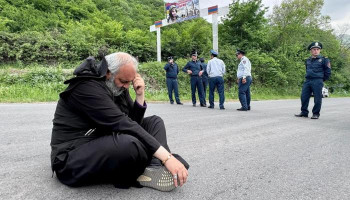Giant Lake Disappears! Experts Blame Global Warming, Pollution
 Bolivia’s second largest lake, which had contained almost 1,200 square miles of water, has almost completely disappeared due to climate change, El Niño weather patterns and severe pollution according to several experts, who say the loss could be permanent. Lake Poopo, which now looks like a large saline desert, has been a source of food and commerce for indigenous and other people in the High Plains of Bolivia for over 4,000 years, as well as being home to thousands of species of wildlife, but problems in the last 30 years have reduced it to a very small and shallow body of water. Scientists say the lake has experienced intense evaporation in the past but this latest episode could be its death knell. The death of the lake has forced thousands of people to leave the area, including many Indigenous Urus Muratos and Aymara peoples. In December, scientists officially announced that the lake had evaporated. Before the series of disasters that had killed it, Lake Poopo had been 52 miles long, 34 miles wide with a total size of 1,200 square miles. “The monitor of Lake Poopo has established that it is almost completely dry,” said Agricultural Engineer and Researcher Milton Perez of Technical University of Oruro (TUO) on December 16. "Lake Poopo has been tracked for about 60 years and there has been evidence that climate change has had an effect in the last decade, from the ’90s in the 20th Century. The temperature has gone up 0.9 degrees Celsius,” Perez noted. “This is a picture of the future of climate change,” said Dirk Hoffman, a German glaciologist who studies how rising temperatures from the burning of fossil fuels has accelerated glacial melting in Bolivia. Andean glaciers are disappearing too which are sources of Lake Poopo’s water. But other factors, such as the El Niño phenomenon, are involved in the demise of Bolivia’s second-largest body of water behind Lake Titicaca. The El Niño phenomenon, a complex series of climatic changes that result in warm waters in the Pacific Ocean that can lead to heavy rainfall in some parts of the world and droughts in others, used to happen once every 10 years, Perez said. “So you have it one year and then another; and Lake Poopo had eight years of normal climate behavior with regards to precipitation and temperature so it maintained its normal status as it had always been,” he stated Now, because of global warming, it happens every three years, he said. “So, one year of El Niño, one year La Niña, and in the best of cases one normal year. One year is not sufficient for the lake to recover. And it's only going to get worse,” Perez asserted. Two of the other damaging factors involve diversion of rivers that feed into the lake by giant mining and agricultural businesses, along with severe pollution of the lake and the tributary rivers that feed into the body of water by the same operations. According to a recent study conducted by Gerardo Zamora of the TUO, the lake was found to have elevated levels of arsenic, lead, cadmium and zinc as well as various types of trash and solid residues. Another warning sign to the recent disaster happened in late 2014 when millions of fish along with about 500 birds died in and around the lake. A similar tragedy occurred in 1992, according to a report entitled “The Environmental Degradation of the Fishing Resources of Lake Poopo.” “In the beginning of 1992, fisherman began to note deformations and reductions in the size of fish…by August of 1992 the fish in the lake went into recession, completely disappearing until May of 1993,” the report noted and that these deformations appeared right after the discovery of yet more mining related pollution in the lake. The report also explained that the lake was the most important resource for fishing in the country, producing thousands of tons of fish per year, and a significant source of food for many low-income people. The authors, Víctor Zabaleta and Michael Bremer, warned that national and international aid would be necessary to preserve the lake for future generations. The recent disappearance of the lake has compelled Governor Victor Hugo Vazquez of Oruro Province to declare an environmental emergency, calling on national and international agencies to help provide funding. Some public officials, including President Evo Morales, have expressed some optimism that the lake will return as it has after other severe droughts. But scientists and others like Perez are not hopeful. “I don’t think we’ll be seeing the azure mirror of Poopo again,” Perez stated. “I think we’ve lost it.” |

















